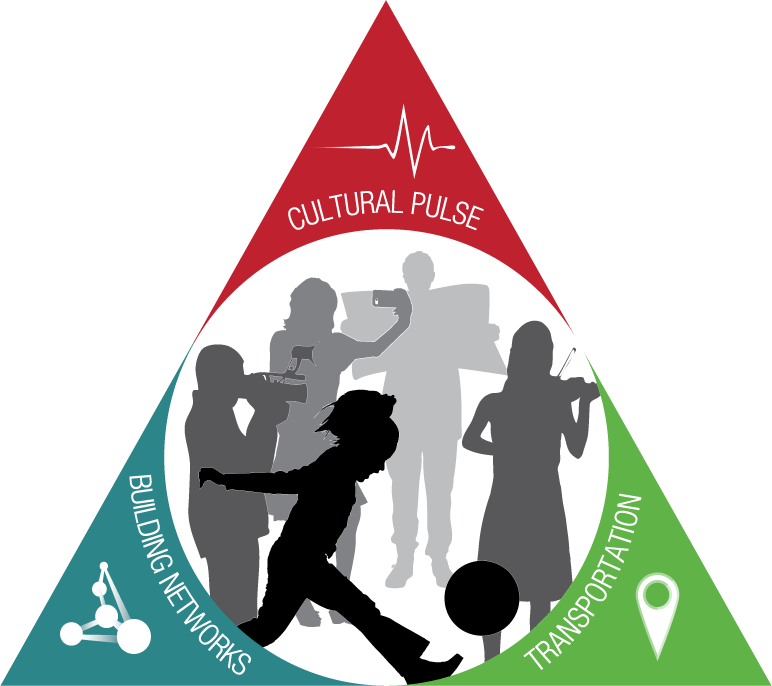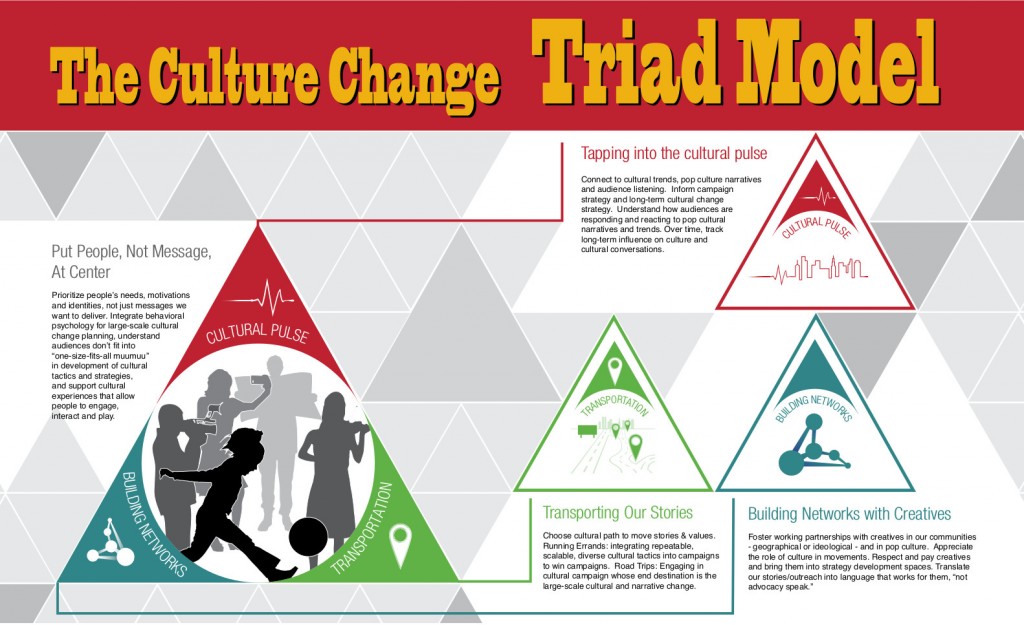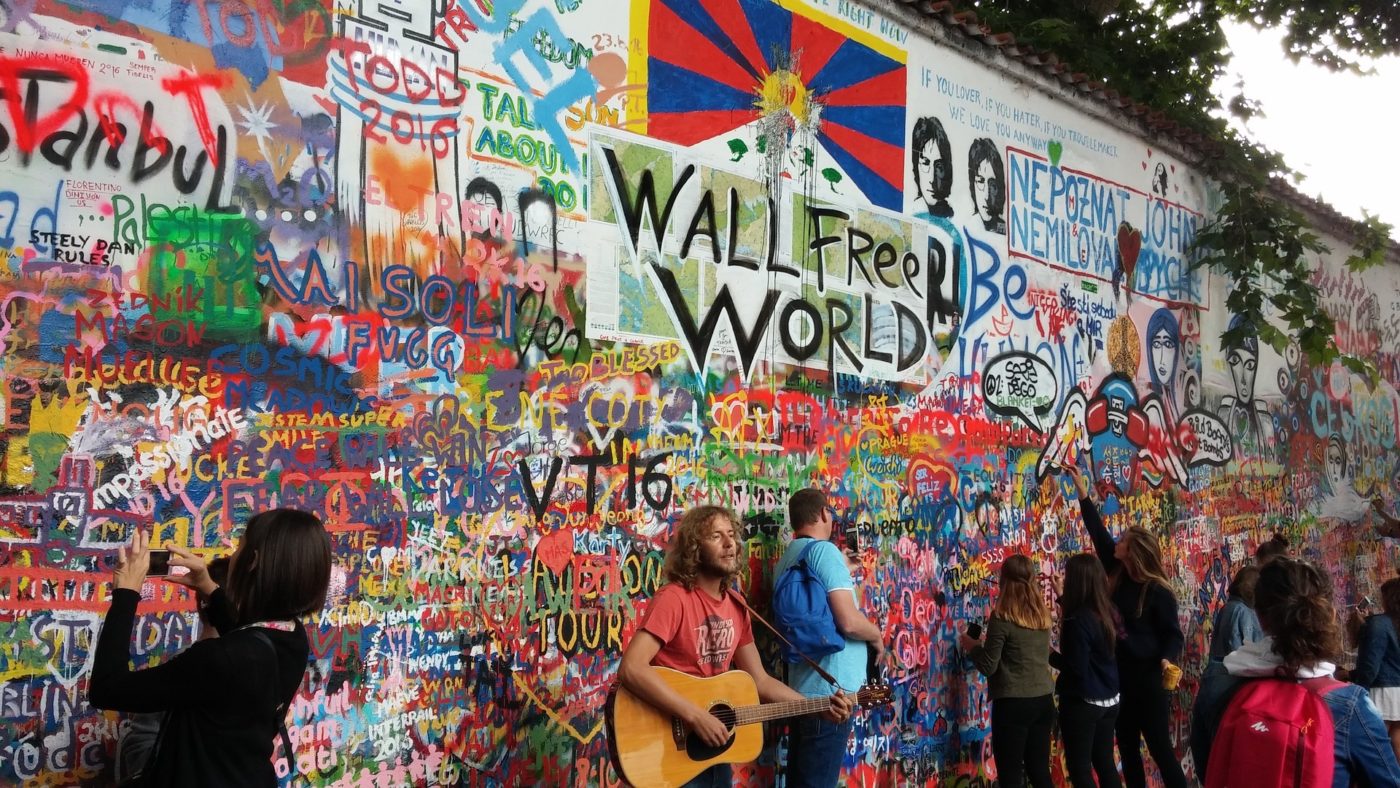American right-wing political agitator and and news pundit Glenn Beck earns an estimated $90 million a year running a media empire aimed at using pop culture to shift cultural values (and political outcomes). Beck has three movies in development, an online TV network with 300,000 paid subscribers, an online news portal with over 25 million monthly visitors and even a line of jeans.
Tracy Van Slyke, a fellow at The Opportunity Agenda and director of the CEL Culture Lab, was struck by the influence of Beck and fellow conservative culture warriors. She spent the past year analysing the intersections between popular media and social change. Van Slyke’s work is presented in Spoiler Alert, How Progressives Will break Through with Pop Culture.
Van Slyke argues that a disconnect between pop culture and progressive political strategies is limiting campaign reach and success. She presents her findings through the lens of the Cultural Change Triad Model, which describes major points where the progressive movement must invest to achieve transformative social change. She shared some of the findings from her report with MobLab.

The culture change triad model presented in Spoiler Alert: How Progressives Will Break Through With Pop Culture
Put People at the Center (Not Messaging)
Van Slyke acknowledges that many tools progressives use to engage people (social media and online organizing, for example) allow activists to reach both individuals and large groups. Conversations have largely gone in only one direction, though: here’s the message, action, or story you should read, sign, share, or like.
Van Slyke urges organizers to go beyond thinking about the messages they want to relay and connect with the lives, identities, and interests of the people they want to reach. “We’re really good at creating videos that go viral, and dropping them into YouTube and then rolling away,” says Van Slyke. “We’re not very good at thinking about the kind of story lines and cultural experiences that really attract people.”
Five Ways to Use Pop Culture in Breakthrough Campaigns
- Put people at the center, not messaging. Better understand the psychological and social needs of your audience.
- Transport your stories – think early on about where stories need to go and how they’ll get there.
- Work with content creators and culture makers as partners, not technicians.
- Stop pretending pop culture doesn’t exist.
- Know your role – not every group can do everything.
In order to attract people (and have them stick by your side), you have to get to know them. What upsets them? What are they really passionate about? Then, try to think of stories or ways to interact with them that really answers those questions.
Want to dig deeper? Van Slyke suggests that campaigners work with behavioral scientists, ethnographic researchers, cognitive linguists, and others who study the relationship between thought and action. Facebook and the video gaming community have already picked up on this method. Reports surfaced earlier this year of Facebook testing the impact of its newsfeed on user happiness. And in 2012, the company tested how its newsfeed affects voter participation.
Games are a fertile environment for learning about and testing human psychology. And gaming psychology is finding its way into social change. Van Slyke discusses the work of game designer and researcher Jane McGonigal as valuable to understanding audience psychology:
“Positive psychology is the relatively new field of science that studies “human flourishing” or how we achieve different kinds of happiness. For just over a decade now, positive psychology researchers have been accumulating a formidable body of knowledge about how our brains and bodies work to help us achieve well-being and life satisfaction….
Since the rise of positive psychology, the creative leaders of the industry have increasingly focused on the emotional and psychological impact of their games. More and more, the directors and designers of major game studios are drawing on research findings from positive psychology to make better games.”
– Jane McGonigal, author of Reality is Broken: Why Games Make Us Better and How They Can Change the World
Van Slyke also tries to drive home the message that audiences are not monolithic. She asks: What are the characteristics that make up these audiences? What are their needs, wants, and goals? What are their interests? They don’t fall into a “one size muumuu” and this influences how progressives should create, drive and respond to content and cultural experiences.
Transport Stories
When progressives talk about “changing the narrative” they’re really talking about influencing the public story. Van Slyke argues that progressives need to develop a strategic road map that marks the stories they want to embed into ongoing cultural conversations.
Even more important is the type of vehicle that will be used to move those stories. She explains:
“Transportation is not only a metaphor for the influence of storytelling, but can also apply to the strategy behind the storytelling. To transport people into believing and connecting with our stories and values, there are two major pathways to integrate cultural change into a particular organization or movement: running errands and going on a road trip.”
Running errands are activities organizers regularly perform, from working with artists on specific projects to promoting personal stories via video in order to amplify the campaign message and engage core communities. Road trips are the long term culture change strategies where the end destination is the culture change itself. These campaigns can last from a year to a decade.
Van Slyke notes that each has different goals: cultural tactics (“errands”) are used to win a specific victory (that sometimes includes narrative change), while the other (“a road trip”) is creating cultural and long-term narrative change that can propel political and societal change forward.
Work with Content Creators and Culture Makers
Faviana Rodriguez of CultureStrike encourages organizers within the social justice field to nurture relationships between organizers and creatives. “Culture creates a ripe environment for issue-based organizing or ‘get out the vote’ efforts,” says Rodriguez. “This is why it’s so important for us to work in unity. We need to understand timing politically to know when it makes sense for cultural interventions to happen.”
Van Slyke adds that progressive organizations and allies can (and must) build working partnerships with artists, creatives, and storytellers and reach out to build relationships with creatives and producers who operate in the for-profit, pop culture spaces.
If an organization wants to work with an artist, they need to pay them, and pay them well. They also need to be brought to the strategy table much earlier on rather than towards the end of the campaign. “Artists think in narratives and visuals… in ways which help shift campaigns and campaign strategies from the get-go,” says Van Slyke. Some social justice organizations look to Hollywood and other pop culture sectors for the quick celebrity endorsement, and while that can be a powerful tactic for a campaign to raise awareness, it’s not a long-term strategy for advancing change through culture. Get the creative interested in the issue over time.
Stop Pretending Pop Culture Doesn’t Exist
“It’s considered too soft, too weak, too hard to measure,” says Van Slyke when describing how many activists and leaders view pop culture. Yet, by ignoring pop culture, progressives are missing out on opportunities to spread their message far and wide.
Van Slyke spoke about the fear of perpetuating stereotypes within pop culture and concerns of “low brow” entertainment but concludes that “it still doesn’t mean it’s not reaching millions of people and it’s not incredibly powerful.” As mentioned earlier, Hollywood can be a key industry to connect to, but part of that strategy development is to build relationships with people in the industry, allowing industries to “break new ground in the intersection of storytelling and engagement landscape.”
Politicians understand the potential power of pop culture. In 2014, President Obama spoke about the Affordable Care Act on Between Two Ferns, an online series by Funny or Die.
Today, though, this isn’t just about Hollywood. Personalities on YouTube and Vine are gaining thousands to millions of fans. “The conversations, framing, and opinions on issues progressives care about reaching millions of people—especially young people—are happening in new cultural arenas,” says Van Slyke.
With more scripted content coming to YouTube, audiences feel more intimacy and connection to content creators than they do to characters on network television. The Lizzy Bennet Diaries and The Misadventures of Awkward Black Girl are two web series that Van Slyke cites as breaking storytelling boundaries.
The Serial podcast offers another current example of how storytelling (and commentary) can reach a broad new audience. Serial is basically a 10-week true crime radio show that barely, if at all, touches on issues of media access, race and fairness in the criminal justice system. But the show’s popularity and uniqueness has sparked conversations about these issues all the same.
Know Your Role
“This report is not a way of throwing down the gauntlet and saying, everyone has to take on culture change work,” says Van Slyke. But for those who are interested, it’s about understanding what will work best for your organization, whether that is embedding cultural tactics into a campaign or providing financial assistance to creatives and storytellers.
Van Slyke lays out these final points to any progressive organization that wants to make culture central to their DNA:
- Have a vision of how integrating cultural strategies and practices will propel your work forward, whether for campaigns or big-picture narrative shifting.
- Take a look at the Culture Change Triad model and determine what your role can be in the progressive culture change space.
- Listen to the communities you’re trying to reach to help inspire and shape cultural strategies and products.
- And lastly, develop networks with all the essential players: creatives, allies, and strategists.
Now it’s time to let the experimentation in culture change begin. As Van Slyke reminds us, this transformation will be ongoing and cumulative, because cultural and political shifts happen over time. Remember to work with allies and invest in creative individuals and organizations that are making that cultural change. And feel free to begin a dialogue with fellow readers and offer ideas and examples in the comments!

The culture change Triad Model presented by Spoiler Alert: How Progressives Will Break Through with Pop Culture.




